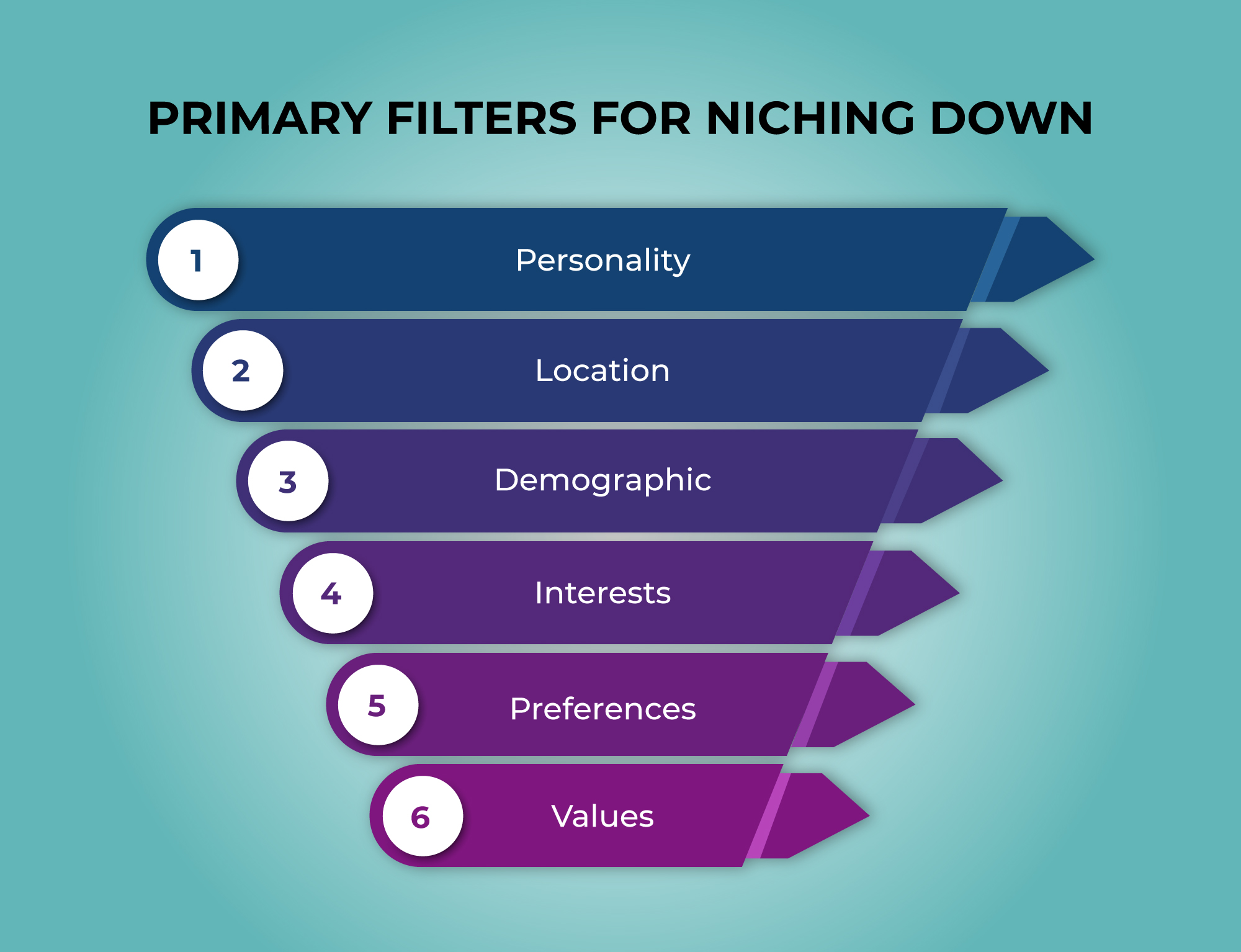
An entrepreneur who is about to take off on a business journey must be visionary. A confident visionary pursues one clear goal instead of casting a wide net. What is my big idea? Who does my idea best suit? How, where, and when can I ensure that the right people discover my business? This path of inquiry ultimately makes an entrepreneur’s dream come true, down to the finest detail. We call this focused goal a niching down. It’s rather elementary: if you want to know the primary source of your revenue, you need to work out how you’ll be niching down.
Before niching down…
Finding a niche isn’t the first thing you do because if you focus too much on your specialisation before you’ve even begun, you might wind up going in the wrong direction. So, it would help if you first did the spadework and laid the foundation. Then, with time and experience, you must figure out where you’re doing best. With this understanding, you can figure out where most of your clients are, which service generates the most revenue, where you are most in your element, and doing your best work. That’s when the process of niching down will become apparent to you.
What is niching down?
Once you’ve found your niche, it’s time to focus on developing that aspect of your business and becoming an expert in the field. When you do this, your target audience will be small, your specialisations precise, and your services client-focused. During this process, you will also discover sub-niches. However, since this market is relatively unexplored, potential customers will have limited options for the service you provide.
When you are a minor player in a vast, competitive market where big names and their extensive resources abound, your business relationship with your client starts on an unequal footing—the client has all the decision-making power and may not respect your expertise in the field. This power imbalance leads to more compromises on your side; you will not be operating at your best. On the other hand, if you work within your specific niche, the dynamic is closer to equal, and the client will be more confident in your ability to deliver.
Being in your specialised zone also means you can get to the top quickly, and there’ll be much less competition. Your clients will feel more deeply connected to you; you, too, will have a great feeling of belonging. You can speak your audience’s language better than the more prominent, more general names. It’s like Bruce Lee says, “I fear not the man who has practised 10,000 kicks once, but I fear the man who has practised one kick 10,000 times.” With all that experience, the solutions and troubleshooting come easier, which in turn will help you build even more trust with your clients. When you go bigger and diversify, you have a loyal base and a greater understanding of the playing field.
How can you start?
When you find your audience and cater to their specific needs, you will also find that your advertising has a more precise meaning. And with social media providing the platform for growth in the way that it does today, promoting your brand becomes much more effective.
There are three factors to remember while niching down:
- Demography: Does your product have to do with people’s age/gender/nationality or other inherent factors? For instance, Lefty’s—the Left Hand Store in Florida, is an American brand that caters specifically to left-handed people. Their customers feel seen and liberated from the right-hand bias in everyday equipment design.
- Sector: Perhaps your classification is based on someone’s profession, like how Square helps small businesses with sales transactions, inventory, and other financial services.
- Specific need: Your service could be to satisfy a particular requirement. UNTUCKit offers shirts that are the perfect length for casual wear that you don’t need to tuck in. They saw that most men’s shirts looked frumpy when untucked, and they met that need.
Once you find the key factors that drive your niche, you can double down on serving them.

Successful examples of niching down
The following brands have secured competitive advantages simply by marketing a clear-cut niche.
- When you look closely at notable content creators, you realise they are excellent at thriving in niches. Most creators focus on categories like fashion, comedy, lifestyle, etc. Still, they always look for what kind of content within the category becomes viral. This constant search for the perfect niche further helps to open specific doors for them as far as influencer marketing is concerned. So, if you’re a food blogger, stay focused on a particular cuisine or presentation that sets you apart from the crowd. Such an approach will be way better than yet another picture of a fudgy brownie. Sortedfood, for instance, started as a channel where a chef teaches his normal (non-chef) childhood buddies how to cook. However, they soon realised that the camaraderie between the lads drew people to their show. So, the show remained food-centric but also lad-centric, with the audience getting to know each man as a character. Over the years, they capitalised on that and built a channel where the ‘normals’ compete with each other, review pretentious ingredients and kitchen appliances, travel, and explore food trends. The show is for those curious about food and for those who enjoy a good laugh, not necessarily for those looking for straightforward, instructive recipes.
- International brands like Whole Foods and Lush recognised the demand for organic, vegetarian, cruelty-free, responsible products and catered to those consumers. They’re not looking to be the cheapest product on the market because that’s not what their clientele wants.
- Rolls Royce isn’t over here trying to be a family car: their brand is about luxury, extravagance, and royalty. They take their exclusivity to a whole other level and are known as an ‘ultra-niche brand’. In fact, the CEO Torsten Müller-Ötvös’s exact words were, “We are not lowering prices just for the sake of volume. That’s not Rolls Royce. We are luxury goods. We are not in the car business at all”. They even have a narrower dealer network than their competitors, spread only across 50 countries.
- Al Baik, a major chain of fast food restaurants, limited their business to Makkah and Jeddah for the longest time. It got so popular that everyone who went to the Holy City had to have an Al Baik meal. Their focused values of assured quality, fast service, and social responsibility soon got recognised. It’s only been a while since they opened all over Saudi Arabia and other parts of the Middle East. Still, the hype shows no signs of diminishing. And the whole time, all it really is is a fried chicken restaurant.
What’s the endgame?
The lesson here is that you don’t need to try to be everything all at once. Sometimes, you go to a restaurant to find that it has virtually everything on the menu, and none of it tastes great. But, on the other hand, in nearly every city, some restaurants need no advertising. They do just one or two things, and they do it so well that their product is well-received.
After you’ve found your niche, made those connections, and built your brand, you need to expand and branch out. Once you learn to swim in the pond, try the lake, the river, and so forth. It’s important to avoid getting so comfortable that you delve deeper into your existing niche. Instead, you should create more niches and grow as you go along.


